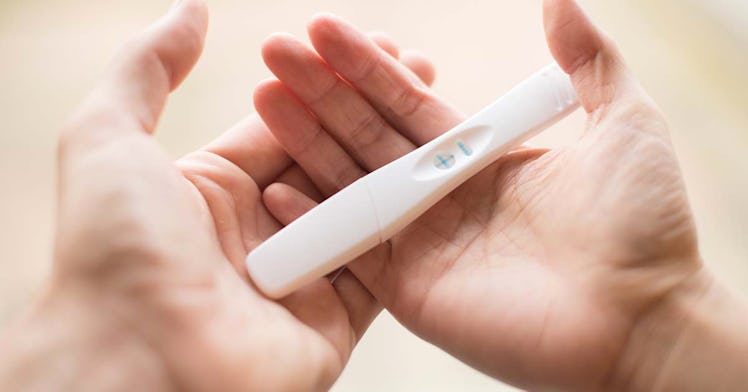What To Make Of The Dreaded Faint Line On A Pregnancy Test
From false positive pregnancy tests to faint lines, here's what's happening when your partner pees on the stick.

Couples hoping for a positive pregnancy test can have their patience tested while waiting for results — even if the wait is as short as one minute for some home tests. And when the result does show, there’s always the fear of false positives, false negatives, and faint lines on the pregnancy test. So it’s helpful for couples to understand what home pregnancy tests are actually measuring and how sophisticated they’ve become since their first appearance 60 years ago. Because understanding how pregnancy tests work can help couples read them correctly and boost confidence in a positive pregnancy test result.
What a Pregnancy Test Measures
A positive pregnancy test measures the presence of a hormone called Human Chorionic Gonadotropin (hCG) in the urine. The hCG hormone is produced by the placenta and can be detected in minute amounts as soon as a fertilized egg has implanted in the lining of the womb. Couples can get a positive pregnancy test result as early as 8 days after ovulation and 8 days before a missed period.
How a Pregnancy Test Works
All stick-style home pregnancy tests essentially do the same thing: Urine is deposited on one end of the testing device and wicked via microcapillary material through the test substrate. For home pregnancy tests, the substrate is basically a strip of material with antibodies that react to the presence of hCG. When the substrate reacts with the urine, it produces a reaction that displays the result.
Fairly recently in history, finding out how your were pregnant was far more complicated. “Back in the late 60s, we were still injecting the urine of women into rabbits. It sounds gross, but it’s true,” says Mary Jane Minkin, M.D., Clinical Professor of Obstetrics, Gynecology and Reproductive Sciences at Yale University School of Medicine. The process back then relied on the presence of estrogen in the urine. “The extra estrogen would cause the rabbit’s uterus to get big.”
If you’ve ever heard someone use the euphemism “the rabbit died” for a woman getting pregnant, this is likely where it came from — though there’s little evidence to suggest the rabbits actually died from the process.
False Positives on Pregnancy Tests
Most home pregnancy tests claim to be 99% accurate in detecting pregnancy. But the body does produce hormones that can cross-react with antibody tests, according to Minkin. “The luteinizing hormone, which is made by the pituitary gland, triggers ovulations by helping to kick the egg out of the ovary and can cross-react,” she says. That’s particularly important for couples who are undergoing fertility treatments. “Sometimes we administer a large dose of LH to induce ovulation. If you have a bunch in your system, there can be a remote possibility of cross reactivity.”
False Negatives on Pregnancy Tests
Because tests rely on the detection of hCG, there needs to be a concentration of the hormone before it can work. Current tests require at least 8 or 9 international units of hCG per milliliter. If the concentrations are too low, there is unlikely to be a positive result. If a couple has missed a period and a test comes back negative, the best course of action is to retest or visit an OBGYN for confirmation.
Faint Line on a Pregnancy Test
At-home pregnancy tests largely distinguish themselves through their speed (as quick as a minute), or the means by which they indicate results (digitally, using pluses, minuses, lines, or colors). But the indicators aren’t always clear. Occasionally, because nerves are running high, user error, or manufacturing differences between tests, the results may be faint or appear ambiguous.
But home pregnancy tests don’t give “maybe” as an answer. They either detect adequate hCG levels or not. Very occasionally, on some tests, urine wicked into the result window area can evaporate and cause an indicator to faintly appear. In cases where the test has been checked within the recommended time, evaporation-derived indicators are unlikely to show. The chances are, if a couple has used the test correctly and an indicator appears, they are pregnant. That said, there’s nothing wrong with a redo.
Minkin, who has consulted for First Response, notes that the company has an app for this circumstance. Users can point their phone camera to their test and the app will give a clear “pregnant” or “not pregnant” based on the indicator lines.
It’s certainly better than checking to see if the rabbit’s uterus grew.
This article was originally published on